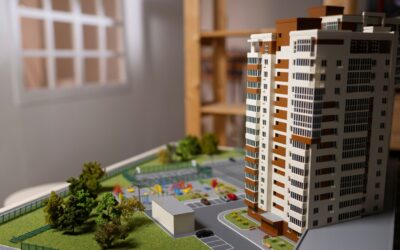After months of uncertainty, the new administration’s tariffs are in full effect — and they’re more severe than analysts anticipated.
A 25% tariff now applies to most goods from Canada and Mexico, and another 10% hits imports from 57 other countries.
Some trading partners face additional duties ranging from 1% to 50%. China is looking at a total tariff load of 54%, while all European Union goods are tagged with a flat 20%.
Markets reacted immediately: the S&P 500 plunged and lost $5 trillion in value in just two days.
Governments around the world promised retaliation, and the threat of a global trade war started to look real.
And while these movements affect nearly everyone, commercial real estate is especially exposed.
Unlike some sectors, CRE developers must navigate not only fluctuating construction costs but also the ebbs and flows of consumer demand, the fragility of supply chains, and the dynamism of business expansion — all factors directly vulnerable to the instability brought about by tariff volatility.
In this blog, we look at the effects of Trump’s tariffs on real estate and CRE development costs in 2025.
Overview of Trump’s tariff policies
The administration’s tariff rollout quickly hit key imports — especially metals. The US slapped new duties on Chinese steel, aluminum, and other materials essential to construction, and a 10% blanket tariff applied across a wide range of imports added even more strain.
Industrial and retail real estate are among the first to feel the hit as both sectors are closely tied to consumer demand and global supply chains.
As tariffs disrupt industries like automotive, electronics, and consumer goods, the warehouses and storefronts that support them take collateral damage.
CBRE expects companies to pause lease signings amid the uncertainty and instead turn to third-party logistics providers. In Southern California and the Northeast, for example, Asian logistics firms now occupy around 20% of warehouse space — up sharply as they brace for trade friction.
Direct impact on CRE development and construction
Impact of steel tariffs on construction
The new tariffs have thrown a wrench into the construction planning process. Materials like steel and aluminum, which were already under pressure from earlier trade actions, are now facing additional duties that ripple across project budgets.
The Construction Monthly Metals Index broke its months-long stable pattern and dropped 5.41%, a signal of increased short-term volatility.
Analysts say this drop reflects mounting pressure on core materials like H-beam steel and rebar, both of which are directly affected by the US-China trade standoff. As long as that impasse continues, pricing will remain unpredictable.
Aside from raw steel and aluminum, the latest round of tariffs also affects structural components, copper wiring, machinery, fasteners, and other finished construction products.
Note that while raw copper remains exempt, many of its finished forms do not — and that’s where builders are starting to feel the squeeze.
According to the latest US Producer Price Index, industrial metals costs began climbing within weeks of the expanded tariffs, adding pressure to already-tight project margins.
US steel and aluminum producers have gained a short-term boost as the trade barriers favor domestic supply. But the downstream impact is more complicated.
Construction firms, real estate developers, and manufacturing operations that rely heavily on these materials now face higher input costs.
Project budgets are tightening, too. Delays and cancellations are becoming more likely especially for developments that can’t absorb unexpected price swings.
Influence on project timelines and contractor behavior
With materials getting more expensive, contractors are adjusting how they bid and build. Fixed-price and GMP contracts now carry higher risks because unexpected cost jumps can eat into margins.
Some contractors are stockpiling supplies ahead of price hikes, while others are writing escalation clauses into contracts. Both strategies can delay timelines and drive developer costs up.
Real-world data on cost escalations
Recent data shows construction input prices rose 1.4% in January — that’s the sharpest monthly increase in two years.
The jump came from a mix of rising energy prices and a rush to buy materials before tariffs kicked in. Notably, Canadian lumber spiked 14.5%, and concrete climbed 8%.
Regional and sector-specific impacts
States like California, Texas, and Florida — where imported materials are a bigger part of the supply mix — are especially exposed.
In the multifamily sector, developers may delay or scale back new builds to manage costs, which could then tighten rental supply and drive-up rents.
Clean energy projects are also feeling the pinch since tariffs now hit metals critical for solar, wind, and grid infrastructure.
Indirect impact on CRE asset classes
Industrial and logistics properties
Higher tariffs have pushed many companies to rethink their supply chains.
Some are reshoring operations while others diversify manufacturing hubs to avoid future trade disruptions.
In theory, this shift should fuel demand for domestic logistics space — but that growth comes at a cost, as materials like steel and aluminum now carry higher price tags and make it harder to build new warehouses at scale.
Retail sector
Retailers (especially smaller ones) are struggling to absorb the price increases tied to imported goods.
Tariffs on everyday items like electronics, clothing, and toys are pushing up consumer prices, which cuts into sales. The pressure on margins could lead to tenant turnover.
Office and mixed-use developments
With construction costs climbing and ongoing economic uncertainty making future returns harder to predict, developers are pulling back from new office and mixed-use projects.
This hesitation is slowing the pipeline and putting some planned developments on hold.
Multifamily and affordable housing
Affordable housing and multifamily projects are especially vulnerable to rising material costs.
Tariffs on core inputs like steel, aluminum, and concrete could force developers to scale back unit counts or delay projects altogether, which could potentially make it even more expensive to rent.
Financing and investor confidence
Lenders have started tightening their standards, and inflation and supply chain risks worsen. Underwriting is stricter, and loan terms are less favorable.
Lenders want assurance that projects can weather cost escalations. As a result, developers may need more capital upfront—or be prepared for slower approvals.
Tariffs and commercial real estate financing
Private commercial lenders are stepping in with commercial real estate bridge loans and hard money financing as traditional banks become more selective.
These loan products provide the speed and flexibility needed to keep CRE projects moving even as material costs rise and timelines shift.
In today’s environment, CRE investors need access to adaptable capital more than ever, and private lenders are filling that need.
Strategies for CRE investors to navigate tariff volatility
- Diversify portfolios across asset classes and geographies to reduce exposure to localized disruptions. Office, industrial, retail, and multifamily each respond differently to economic shocks. Some regions may feel the brunt of higher construction costs, while others stay relatively insulated.
- Use long-term fixed-rate financing to hedge inflation. Interest rate swings often follow inflationary pressures, especially when tariffs are involved. Locking in long-term fixed-rate loans now helps protect cash flow later — it stabilizes debt service and cushions returns against rising borrowing costs.
- Consider value-add acquisitions instead of new construction. In a high-cost environment, it can be more efficient to improve than to build. Value-add properties offer upside without the full exposure to expensive new materials. Renovations and operational upgrades can still deliver returns without the same risk of project overruns.
- Stay informed about tariff policies and their downstream effects on labor and material pricing. Tariffs are fluid, and their effects ripple out in unexpected ways. Keep up with changes in trade policy and material indexes to make sharper calls on when and where to move capital.
Do you need a CRE loan private commercial lender flexible enough to help you keep deals moving? Private Capital Investors funds commercial properties between $2 million and $50 million — and more importantly, you can count on us to move fast, with approvals in 24 to 48 hours and funds delivered within two weeks. Call us at (972) 865-6206.
Sources
- https://www.businessinsider.com/tariffs-trump-steel-aluminum-tiles-development-real-estate-construction-2025-3
- https://oilprice.com/Metals/Commodities/Construction-Firms-Brace-for-Increased-Costs.html
- https://www.numberanalytics.com/blog/impact-commercial-real-estate-tariffs
- https://www.northspyre.com/blog/commercial-real-estate-tariffs
- https://www.architecturaldigest.com/story/heres-what-250-billion-in-china-tariffs-means-for-the-design-industry
- https://natlawreview.com/article/rising-construction-costs-2025-tariffs-gmp-and-fixed-price-contracts
- https://www.constructiondive.com/news/tariff-fears-biggest-construction-cost-jump-2-years/740116/
- https://www.businessinsider.com/tariffs-trump-steel-aluminum-tiles-development-real-estate-construction-2025-3
- https://www.pbmares.com/tariffs-and-their-impact-on-the-real-estate-industry
- https://www.investopedia.com/tariff-uncertainty-could-slow-the-decline-in-u-s-rents-11716749
- https://www.benreinberg.com/blogs/how-to-protect-your-cre-investments
- https://www.costar.com/article/918881581/blackstone-sees-buying-opportunity-in-economic-gyrations-from-shifting-us-tariff-policy
- https://artafinance.com/insights/navigating-your-portfolio-through-tariff-driven-volatility





